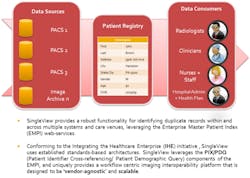With new imaging requirements in Stage 2 meaningful use, IT departments are going to have to start the arduous task of integrating imaging into clinical workflows.
Despite a recent report from Frost & Sullivan that says the radiology picture archiving and communication systems (PACSs) industry will see slow growth over the coming years, there will likely be an expansion in interoperability solutions to enable organizations to meet new requirements in Stage 2 meaningful use to include viewing of image data within the EHR. The proposed rule had required that EHRs support “download and transmit” of DICOM images to third-parties, but it was dropped in the final rule, likely due to the lack of organizational readiness.
It’s apt that more organizations will be following a path similar to the University of Pittsburgh Medical Center (UPMC) health system, which is successfully federating multiple imaging archives (UPMC has 12 PACS systems in radiology alone) into a more “patient-centric” view, where all images are pulled together in one federated diagnostic image repository, called SingleView.
My colleagues have done a great job covering SingleView previously, but I wanted to get a update on SingleView’s progress from Dr. Rasu Shrestha, UPMC’s vice president for medical information technology and medical director for interoperability and imaging informatics. SingleView, developed in 2008, flows in several ‘ologies of images including cardiology, radiology, gastroenterology, ophthalmology, dermatology, ENT, and neurology. The repository has now been deployed across 22 hospitals and 30 imaging centers; and there is close to 1 petabyte worth of radiologic images stored in its servers (out of 3.2 petabytes of data and images system-wide). UPMC actually doubles its total image storage every 18 months.
“SingleView creates a federated PACS and matches the patient’s identities and medical record number with his or her other records across the enterprise, all in a single view,” Shrestha says. “It is meant to be a patient-centric platform and directly integrate into the clinical workflow. The notion of SingleView was to make it into multi-ology aggregation platform.”
Shrestha sees UPMC’s enterprise imaging strategy as a journey, not an end goal. “SingleView is a process of getting to this patient-centric approach to care. We’re working steadfastly to aggregate additional sources of data around the patient’s context. We have initiatives at UPMC to get additional sources of what we call clinical context—whether it’s different types of imaging data, audio, or video images.”
One of these initiatives is an ongoing project to create what is termed as the Clinical Content Foundation, which “provides a singular place to house all of the patients’ [non-DICOM] content that you don’t typically house in EMR systems and PACS systems.” Work still needs to be done to integrate these non-DICOM images into the clinical workflow, providing the right XDS handshakes to funnel images into SingleView.
“If you were producing a report on your EMR on a wound image that you captured [it’s important] that you’re able to integrate the right links directly into the body of the report itself,” says Shrestha. “So we’ve thought through the process, and we’re looking beyond the immediate needs, and we’re looking at what are the ancillary workflows that need to be addressed to get to this eventual goal.”
Sponsored Recommendations
Sponsored Recommendations


